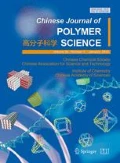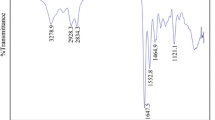Abstract
The development of adhesive technology is gaining increasing attention in machinery, electronics, aviation, and other fields. However, traditional adhesives are difficult to be peeled and removed after cross-linking and curing due to the limited solubility in common solvents, which causes pollution and damage to the surface of the adherend. In this work, we synthesized random hyperbranched polyamide-amine hot melt adhesives through Michael addition of 1,8-octanediamine and N,N’-methylene diacrylamide (ODA-RHP HMA). Owing to the presence of various polar groups, ODA-RHP HMA exhibited robust lap shear strength to different substrates, including glass (6.6 MPa), ceramics (10.3 MPa), steel (11.5 MPa), and aluminum (11.8 MPa). Due to the hydrogen bonds in ODA-RHP, the HMA demonstrated intrinsic self-healing ability, which can be used repeatedly when being subjected to cyclic heating and cooling. Since ODA-RHP HMA can be swollen or dissolved in ethanol, the adhesives can be easily removed through erasing. In addition, ODA-RHP exhibited aggregation-induced luminescence due to the tertiary amine structure in the molecular structure of ODA-RHP, which can be used in the field of cultural relics restoration.
Similar content being viewed by others
References
Matos-Perez, C. R.; White, J. D.; Wilker, J. J. Polymer composition and substrate influences on the adhesive bonding of a biomimetic, cross-linking polymer. J. Am. Chem. Soc. 2012, 134, 9498–9505.
Kinloch, A. J. Toughening epoxy adhesives to meet today’s challenges. MRS Bull. 2003, 28, 445–448.
Pruksawan, S.; Samitsu S.; Yokoyama, H.; Naito, M. Homogeneously dispersed polyrotaxane in epoxy adhesive and its improvement in the fracture toughness. Macromolecules. 2019, 52, 2464–2475.
Lettieri, M.; Frigione, M. Natural and artificial weathering effects on cold-cured epoxy resins. J. Appl. Polym. Sci. 2010, 119, 1635–1645.
Ma, Y.; He, L. POSS-pendanted in epoxy chain inorganic-organic hybrid for highly thermo-mechanical, permeable and hydrothermal-resistant coatings. Mater. Chem. Phys. 2017, 201, 120–129.
Ma, Y.; He, L.; Jia, M.; Zhao, L.; Zuo, Y.; Hu, P. Cage and linear structured polysiloxane/epoxy hybrids for coatings: surface property and film permeability. J. Colloid Interface Sci. 2017, 500, 349–357.
Wen, L.; Bouzidi, L.; Narine, S. S. Current research and development status and prospect of hot-melt adhesives: a review. Ind. Eng. Chem. Res. 2008, 47, 7524–7532.
Engels, H. W.; Pirkl, H. G.; Albers, R.; Albach, R. W.; Dormish, J. Cheminform abstract: polyurethanes: versatile materials and sustainable problem solvers for today’s challenges. Angew. Chem. Int. Ed. 2013, 52, 9422–9441.
Guo, J.; Xiang, H. X.; Wang, Q. Q.; Guan, F. C. Research progress of hot-melt adhesives. China Adhesives 2010, 19, 54–58.
Sun, L.; Li, K.; Xue W.; Zeng, Z. The effect of primers on adhesive properties and strength of adhesive joints made with polyurethane adhesives. J. Adhes. Sci. Technol. 2017, 31, 327–344.
Waites, P. Moisture-curing reactive polyurethane hot-melt adhesives. Pigm. Resin Technol. 1997, 26, 300–303.
Cui, C. H.; Chen, X. X.; Ma, L.; Zhong, Q. Y.; Li, Z.; Mariappan, A.; Zhang, Q.; Cheng, Y. L.; He, G.; Chen, X. Dong, Z.; An, L.; Zhang, Y. F. Polythiourethane covalent adaptable networks for strong and reworkable adhesives and fully recyclable carbon fiber-reinforced composites. ACS Appl. Mater. Interfaces 2020, 12, 47975–47983.
Wang, S. L.; Liu, Z. H.; Zhang, L. Z. Strong, detachable, and self-healing dynamic crosslinked hot melt polyurethane adhesive. Mater. Chem. Front. 2019, 3, 1833–1839.
Kaya, E.; Mathias, L. J. Investigation of melting behaviors and crystallinity of linear polyamide with high-aliphatic content. J. Appl. Polym. Sci. 2011, 123, 92–98.
Latko-Duraek, P.; Macutkevic, J.; Kay, C. Hot-melt adhesives based on co-polyamide and multiwalled carbon nanotubes. J. Appl. Polym. Sci. 2018, 135, 45999.
Wang, H.; Liu, H. C.; Cao, Z. X.; Li, W. H.; Huang, X.; Zhu, Y.; Ling, F. W.; Xu, H.; Wu, Q.; Peng, Y.; Yang, B.; Zhang, R.; Kessler, O.; Huang, G. S.; Wu, J. R. Room-temperature autonomous self-healing glassy polymers with hyperbranched structure. Proc. Natl. Acad. Sci. 2020, 117, 11299–11305.
Xu, Z.; Xiong, X. Q.; Cheng, L. Novel hyperbranched polyimides from 2,6,12-triaminotriptycene. Chinese Chem. Lett. 2008, 19, 1127–1130.
Mijovi, J.; Risti, S.; Kenny, J. Dynamics of six generations of pamam dendrimers as studied by dielectric relaxation spectroscopy. Macromolecules 2007, 40, 5212–5221.
Jorg, I.; Rolf, M.; Fritz, V. Dendrimers: from generations and functional groups to functions. Angew. Chem. Int. Ed. 1995, 33, 2413–2420.
Cui, C. Y.; Fan, C. C.; Wu, Y. H.; Xiao, M.; Liu, W. G. Water-triggered hyperbranched polymer universal adhesives: from strong underwater adhesion to rapid sealing hemostasis. Adv. Mater. 2019, 31, 1905761.
Hong, C. Y.; You, Y. Z.; Wu, D.; Liu, Y.; Pan, C. Y. Thermal control over the topology of cleavable polymers: from linear to hyperbranched structures. J. Am. Chem. Soc. 2007, 129, 5354–5355.
Wu, J. R.; Cai L. H.; Weitz, D. Tough self-healing elastomers by molecular enforced integration of covalent and reversible networks. Adv. Mater. 2017, 29, 1702616.
Huang, Z. Z.; Wan, X. M.; Xiao, H. B. A novel soluble polyamide containing xanthene structure and trifluoromethylphenoxy pendent. Chinese Chem. Lett. 2010, 21, 242–244.
Wei, H. T.; Yang, Y.; Huang, X.; Zhu, Y.; Wang, H.; Huang, G. S.; Wu, J. R. Transparent, robust, water-resistant and high-barrier self-healing elastomers reinforced with dynamic supramolecular nanosheets with switchable interfacial connections. J. Mater. Chem. A 2020, 8, 9013.
Bhullar, K. A.; Meinel, A.; Maeder, K. Advanced spectroscopy, microscopy, diffraction and thermal analysis of polyamide adhesives and prediction of their functional properties with solid-state NMR spectroscopy. Polym. Chem. 2021, 12, 1487–1498.
Yi, P. Q.; Li, M. T.; Yu, W.; Guan, S. Y. Novel hot-melting hyperbranched poly(ester-amine) bearing self-complementary quadruple hydrogen bonding units. Chinese Chem. Lett. 2008, 19, 868–870.
Dou, X. Y.; Zhou, Q.; Chen, X. H.; Tan, Y. Q.; He, X.; Lu, P.; Sui, K. Y.; Tang, B. Z.; Zhang, Y. M. Clustering-triggered emission and persistent room temperature phosphorescence of sodium alginate. Biomacromolecules. 2018, 19, 2014–2022.
Wang, Y. Z.; Bin, X.; Chen, X. H.; Zheng, S. Y.; Zhang, Y. M.; Yuan, W. Z. Emission and emissive mechanism of nonaromatic oxygen clusters. Macromol. Rapid Commun. 2018, 39, 1800528.
Yuan, W. Z.; Zhang, Y. Nonconventional macromolecular luminogens with aggregation-induced emission characteristics. J. Polym. Sci. Part A: Polym. Chem. 2017, 55, 560–574.
Yu, Z. Q.; Xu, X. M.; Hong, C. Y.; Wu, D. C.; You, Y. Z. A responsive hyperbranched polymer not only can self-immolate but also can self-cross-link. Macromolecules. 2014, 47, 4136–4143.
Han, L.; Lu, X.; Liu, K.; Wang, K.; Fang, L.; Weng, L. T. Zhang, H.; Tang, Y.; Ren, F.; Zhao, C.; Sun, G.; Liang, R.; Li, Z. Mussel-inspired adhesive and tough hydrogel based on nanoclay confined dopamine polymerization. ACS Nano 2017, 11, 2561–2574.
Shao, H.; Stewart, R. J. Biomimetic underwater adhesives with environmentally triggered setting mechanisms. Adv. Mater. 2010, 22, 729–733.
Lu, Q.; Danner, E.; Waite, J. H.; Israelachvili, J. N.; Zeng, H.; Hwang, D. S. Adhesion of mussel foot proteins to different substrate surfaces. J. R. Soc. Interface 2012, 10, 20120759.
Li, J.; Celiz, A. D.; Yang, J.; Yang, Q.; Wamala, I.; Whyte, W.; Seo, B. R.; Vasilyev, N. V.; Vlassak, J. J.; Suo, Z.; Mooney, D. J. Tough adhesives for diverse wet surfaces. Science 2017, 357, 378–381.
Alahakoon, S. B.; Tan, K.; Pandey, H. S.; Diwakara, D.; McCandless, G. T.; Grinffiel, D. I.; Durand-Silva, A.; Thonhauser, T.; Smaldone, R. A. 2D-covalent organic frameworks with interlayer hydrogen bonding oriented through designed onplanarity. J. Am. Chem. Soc. 2020, 142, 12987–12994.
Yao, Y.; Xu, Z. Y.; Liu, B.; Xiao, M.; Yang, J. H.; Liu, W. G. Multiple H-bonding chain extender-based ultrastiff thermoplastic polyurethanes with autonomous self-healability, solvent-free adhesiveness, and AIE fluorescence. Adv. Funct. Mater. 2020, 2006944.
Hong, Y.; Lam, J.; Tang, B. Z. Aggregation-induced emission: phenomenon, mechanism and applications. Chem. Commun. 2009, 40, 4332–4353.
Zhang, H.; Zhao, Z.; Mcgonigal, P. R.; Ye, R.; Liu, S.; Lam, J. Y.; Kwok, R.; Yuan, W. Z.; Xie, J.; Rogach, A. L. Clusterization-triggered emission: uncommon luminescence from common materials. Mater. Today 2020, 32, 275–292.
Luo, J.; Xie, Z.; Lam, J.; Cheng, L.; Tang, B. Z.; Chen, H.; Qiu, C.; Kwok, H. S.; Zhan, X.; Liu, Y. Aggregation-induced emission of 1-methyl-1,2,3,4,5-pentaphenylsilole. Chem. Commun. 2001, 18, 1740–1741.
Chen, X. X.; Zhong, Q. Y.; Cui, C. H.; Ma, L.; Zhang, Y. F. Extremely tough, puncture-resistant, transparent and photoluminescent polyurethane elastomers for crack self-diagnose and healing tracking. ACS Appl. Mater. Interfaces 2020, 12, 30847–30855.
Lee, W. I.; Bae, Y.; Bard, A. J. Strong blue photoluminescence and ECL from OH-terminated PAMAM dendrimers in the absence of gold nanoparticles. J. Am. Chem. Soc. 2004, 126, 8358–8359.
Sun, M.; Hong, C. Y.; Pan, C. Y. A unique aliphatic tertiary amine chromophore: fluorescence, polymer structure, and application in cell imaging. J. Am. Chem. Soc. 2012, 134, 20581–20584.
McFadden, P. D.; Frederick, K. L.; A Argüello; Zhang, Y. Z.; Vandiver, P.; Odegaard, N. UV fluorescent epoxy adhesives from noncovalent and covalent incorporation of coumarin dyes. ACS Appl. Mater. Interfaces 2017, 9, 10061–10068.
Baglioni, M.; Montis, C.; Chelazzi, D.; Giorgi, R.; Berti, D.; Baglioni, P. Polymer film dewetting by water/surfactant/good-solvent mixtures: a mechanistic insight and its implications for the conservation of cultural heritage. Angew. Chem. Int. Ed. 2018, 130, 7477–7481.
Werner; Anthony. Synthetic materials in art conservation. J. Chem. Edu. 1981, 58, 321.
Cataldi, A.; Deflorian, F.; Pegoretti, A. Poly(2-ethyl-2-oxazoline)/microcrystalline cellulose composites for cultural heritage conservation: Mechanical characterization in dry and wet state and application as lining adhesives of canvas. Int. J. Adhes. Adhes. 2015, 62, 92–100.
Acknowledgments
This work was financially supported by the National Natural Science Foundation of China (Nos. 51873170 and 11732012), the National Key R&D Program of China (No. 2019YFA0706801), the Key Laboratory Construction Program of Xi’an Science and Technology Bureau (No. 201805056ZD7CG40), the One Hundred Talents Program of Shaanxi Province and Shaanxi International Science and Technology Cooperation Program Project (No. 2020KW-062). The authors gratefully acknowledge Junjie Zhang at School of Chemistry of Xi’an Jiaotong University for his assistance with DSC, TGA, NMR, FTIR, and UV-Vis analysis.
Author information
Authors and Affiliations
Corresponding authors
Electronic Supplementary Information
Rights and permissions
About this article
Cite this article
Zhang, SJ., Chen, XX., Cui, CH. et al. Strong, Removable, and Photoluminescent Hyperbranched Polyamide-amine Hot Melt Adhesive. Chin J Polym Sci 39, 1319–1327 (2021). https://doi.org/10.1007/s10118-021-2630-z
Received:
Accepted:
Published:
Issue Date:
DOI: https://doi.org/10.1007/s10118-021-2630-z




